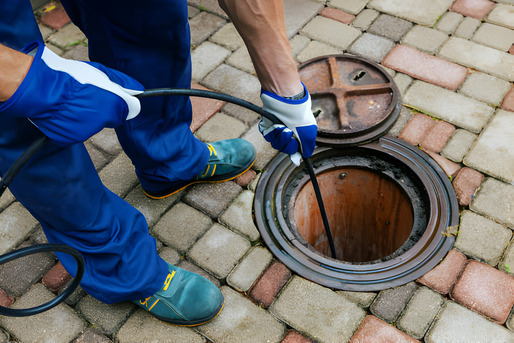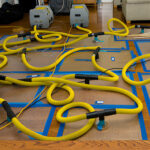
The cleanup of sewage water damage is a difficult task that requires both quick thinking and careful attention to detail. Unexpected sewage backups can leave homeowners with health risks and structural damage to their homes. In this in-depth guide, we set out to demystify the process of cleaning up sewage water damage, offering clear explanations and doable solutions to give homeowners peace of mind in the face of this upsetting circumstance.
The hazards associated with sewage backups are numerous and range from lingering odors in the air to the spread of contaminants throughout our homes. Understanding these risks is the first step toward an effective cleanup. Sewage water damage is more than just an inconvenience; it carries with it a range of health hazards and potential structural issues.
This guide attempts to simplify the process by providing homeowners with a clear, understandable road map to handle the cleanup process and restore their home’s physical and emotional well-being. We do this by breaking down the complexities and providing step-by-step guidance on initial safety measures, removal of contaminated items, cleaning and disinfection techniques, prevention measures, health and safety precautions, and future preparedness.
See also our post on A Comprehensive Guide on How to Save Clothing from Water Damage
Understanding the Risks
Health Hazards
Sewage water contains harmful microorganisms and pathogens that pose serious health risks. Understanding the potential dangers is crucial, as exposure to sewage can lead to various illnesses and infections.
Structural Damage
Sewage backups can cause structural damage to your home. From weakening foundations to compromising the integrity of walls and floors, being aware of potential structural issues is vital for effective cleanup.
Odor Concerns
One of the immediate challenges after a sewage backup is the foul odor. Knowing how to address and eliminate these odors is essential for restoring a safe and comfortable living environment.
Contamination Spread
Sewage water can quickly spread contaminants throughout your home. Understanding how these contaminants move and implementing measures to contain them is key to preventing further damage.
Timely Intervention
Acting promptly is crucial when dealing with sewage water damage. The longer the water sits, the greater the risk of extensive damage and increased health hazards. Timely intervention can significantly mitigate these risks.
Initial Safety Measures
Protective Gear
Before starting the cleanup process, ensure you have the appropriate protective gear. This includes gloves, masks, and waterproof clothing to minimize direct contact with sewage water and its contaminants.
Electrical Safety
Turn off the electricity in affected areas to avoid the risk of electrical shock. Water and electricity are a dangerous combination, and taking this precaution is essential for your safety during cleanup.
Ventilation
Ensure proper ventilation in the affected areas. Open windows and doors to allow fresh air to circulate and help dissipate odors. Adequate ventilation also aids in drying out the space more efficiently.
Evacuation Consideration
If the sewage backup is extensive, consider evacuating the premises until professionals deem it safe. Your safety is paramount, and knowing when to seek temporary shelter is a crucial decision in the cleanup process.
Contacting Professionals
In severe cases, it is advisable to contact professional sewage cleanup services. These experts have the knowledge, equipment, and experience to handle extensive sewage water damage safely and effectively.
Removal of Contaminated Items
Porous Material Consideration
Identify and remove porous materials that have come into contact with sewage water. Carpets, upholstered furniture, and certain types of insulation may need to be discarded due to their inability to be adequately cleaned and disinfected.
Non-Porous Item Cleaning
Clean and disinfect non-porous items that can be salvaged. Hard surfaces such as metal, plastic, and glass can often be effectively sanitized with appropriate cleaning agents.
Personal Belongings Assessment
Assess personal belongings in affected areas. While some items may be salvageable through thorough cleaning, others may need to be discarded. Prioritize safety and hygiene when deciding what to keep and what to discard.
Disposal Guidelines
Follow proper disposal guidelines for contaminated items. Bagging and sealing items before disposal is crucial to prevent the spread of contaminants. Be aware of local regulations regarding the disposal of sewage-contaminated materials.
Salvaging Valuables
For sentimental or valuable items, consult with professional restoration services. Specialized cleaning and restoration techniques may be employed to salvage items that hold significant personal or monetary value.
See also our post on A Comprehensive Guide on Preventing Water Damage in an Urban Environment
Cleaning and Disinfection
Surface Cleaning
Thoroughly clean all surfaces with a detergent or cleaning solution. Scrub surfaces to remove visible debris and contaminants. Pay close attention to areas that may have been overlooked, such as corners and crevices.
Disinfecting Agents
Use a strong disinfectant to kill remaining bacteria and pathogens. Ensure that the disinfectant is suitable for use on surfaces that have been in contact with sewage water. Follow the product instructions for effective application.
Deodorizing Techniques
Address lingering odors by using deodorizing agents. Consider natural deodorizers like baking soda or commercial odor-eliminating products. Adequate ventilation is essential to help eliminate unpleasant smells.
Flooring Restoration
For carpeted areas, consult with professionals regarding the potential for restoration. In some cases, carpeting may need to be replaced, while in others, thorough cleaning and disinfection may be sufficient.
Crawl Space and Basement Considerations
Pay special attention to crawl spaces and basements, as these areas are prone to sewage backups. Adequate cleaning, disinfection, and proper ventilation are crucial in these often overlooked spaces.
Prevention Measures
Identify and Repair Source
Identify the source of the sewage backup and ensure it is promptly repaired. Preventing future incidents requires addressing the root cause, whether it be a clogged sewer line, faulty plumbing, or other issues.
Backflow Prevention Devices
Consider installing backflow prevention devices to minimize the risk of future sewage backups. These devices help prevent sewage from flowing back into your home, providing an additional layer of protection.
Regular Plumbing Maintenance
Engage in regular plumbing maintenance to prevent blockages and ensure proper sewage flow. Simple practices such as avoiding flushing inappropriate items and regular drain cleaning can significantly reduce the risk of backups.
Landscaping Considerations
Evaluate your landscaping to ensure it does not contribute to sewage backups. Proper grading and directing water away from your home can prevent water from accumulating and causing sewage issues.
Professional Inspection
Periodically engage professionals for sewage system inspections. Regular assessments can identify potential issues before they escalate, allowing for timely repairs and preventive measures.
Health and Safety Precautions
Vaccinations
Consider vaccinations for you and your family, especially if exposed to sewage water. Consult with healthcare professionals to determine if additional vaccinations are necessary to prevent waterborne diseases.
Hand Hygiene
Emphasize thorough hand hygiene during and after the cleanup process. Wash hands with soap and water regularly, and use hand sanitizers when soap and water are not readily available.
Avoiding Contact
Minimize direct contact with sewage water and contaminated surfaces. Use tools and equipment for cleaning to avoid skin contact, and ensure that protective gear is worn consistently.
Seeking Medical Attention
Seek medical attention if you experience any symptoms of illness after exposure to sewage water. Prompt medical care can prevent the progression of potential waterborne diseases.
Children and Vulnerable Individuals
Take extra precautions for children, elderly individuals, and those with compromised immune systems. These individuals may be more susceptible to the health risks associated with sewage exposure.
Final Steps and Future Preparedness
Documentation
Document the damage and cleanup process for insurance purposes. Take photographs of affected areas before and after cleanup, and keep a record of expenses related to the restoration.
Insurance Claims
Initiate the insurance claims process promptly. Provide the necessary documentation and information to expedite the claim and ensure a smoother recovery process.
Emotional Well-being
Acknowledge the emotional toll that sewage water damage can take. Seek support from friends, family, or professionals to cope with the stress and anxiety associated with the aftermath of a sewage backup.
Future Preparedness
Learn from the experience and take steps to prevent and prepare for future incidents. Implement preventive measures, engage in regular maintenance, and stay informed about potential risks in your area.
Community Awareness
Share your experience with neighbors and community members. Promote awareness of sewage water damage risks and cleanup procedures to foster a resilient and informed community.
See also our post on How to Save Important Documents from Water Damage
Conclusion
In the aftermath of sewage water damage, the road to recovery may seem daunting, but armed with knowledge and a systematic approach, homeowners can effectively navigate the cleanup process. From understanding the risks to implementing safety measures, removing contaminated items, cleaning and disinfecting, preventing future incidents, prioritizing health and safety, and taking final steps toward recovery, this comprehensive guide provides a roadmap for restoring your home and ensuring the well-being of your family. Remember, a thorough and informed cleanup is not only about restoring your physical space but also about reclaiming the peace and comfort that make a house a home.






